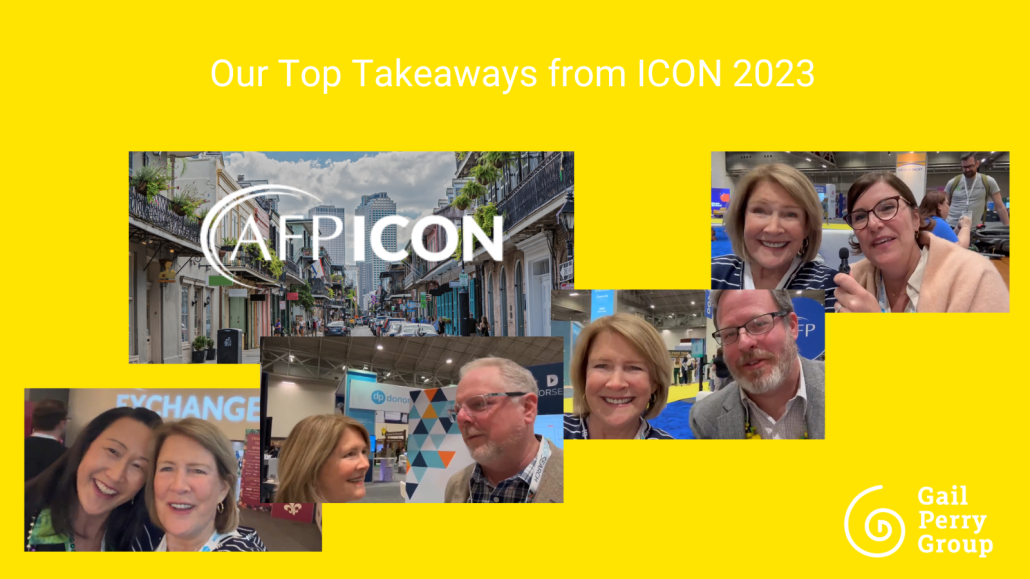ICON Takeways: Strategies, Trends and Data to Guide Your Fundraising

AFPICON was an amazing experience this year. We were pleased that attendance skyrocketed up to over 3500 attendees. (last year, there were around 2600 or so). So interest in fundraising education is high – there’s much to learn and catch up on.
Here are some fascinating takeaways and factoids on the latest research that can inform your fundraising strategies right now. This is just a tiny sample of the fascinating content from ICON. Wish I could have attended more sessions!
Also, I videoed my interviews with several speakers and fundraising pundits, asking for their top tips. You can see all these interviews on our Gail Perry Group LinkedIn page.
Now, drumroll please: I’m sharing the biggest news first – the latest fundraising trend results:
Fundraising Results are Softening Across the Board
The newest report from AFP’s Fundraising Effectiveness Project showed that:
Overall number of donors declines precipitously. While we’ve seen declining numbers of donors over the past few years, it’s gotten worse.
Receive expert advice. Direct to your inbox. Subscribe
- “The long-term trend of waning donor participation, which started in 2012, experienced a sharp decline in 2022, with donors declining by 10%.”
New donor renewals are very soft. It’s interesting to remember that, during the pandemic, we saw many new donors stepping up to help and make gifts. However, now that the pandemic has subsided, these new donors are not renewing.
- The leading cause of donor decline is coming from a reduction in new donors of 18%.
Overall dollar trends are weakening. Even though the overall number of donors has been declining, in the past, we’ve been heartened by seeing the overall dollars contributed going up.
Unfortunately, this recent survey indicates a “notable weakness in total dollars, suggesting the possibility of continued challenges in 2023.”
Your ICON takeaways:
COVID fundraising results are not sustainable.
“As more and more donations are tied up in large donors and the economy hangs in the balance, the health of the sector may be tied to the stock market in 2023,” says Woodrow Rosenbaum, chief data officer of the GivingTuesday Data Commons.
Why Should You Create Campaigns That Appeal Specifically to Women Donors?
Women will, in fact, respond generously when they are approached correctly.
Find out how we can help you achieve your fundraising goals with world-class consulting and custom training.
- Women control 32% of world’s wealth and add $5 trillion to the global wealth pool every year.
- In 2020 in the U.S. alone women, controlled $10.9 trillion to men’s $24 trillion.
- Currently, 45% of millionaires in the US are women.
Today’s Fundraising is in Trouble
Lisa Z Geer, author of Philanthropy Revolution, issued a strong call for change. Based on her own experiences as a philanthropist, she said that standard methods of fundraising developed in the last century have become largely antiquated and even inappropriate.
We can all agree with her that donors come in all shapes and colors, but fundraising continues to focus on the usual suspects – relying on the same donors is unsustainable.
- Many donors, both new and existing, are being turned off for good.
- The rate that fundraisers are leaving the sector is accelerating.
- Our reticence to change is turning off future donors every day.
Your ICON takeaways: Are you open to donors and prospects of all colors and shapes? Do you respond quickly to all donors’ indictions of interest, or just your usual suspects? Be sure you are not leaving money on the table!
Strategic Themes from Bloomerang
Ann Feldman of Bloomerang, Consultants Rachel Muir, Kishshana Palmer and star academic researcher Jen Shang all joined forces to discuss findings from a recent survey of smaller and medium sized organizations. Here’s what they found:
Fundraiser fatigue is real.
We all talk about donor fatigue. Well there’s another kind of fatigue that is running through fundraising shops today. And its fueling the exodus of many fundraising staffers.
The survey found that there’s chronic understaffing across organizations. To make matters worse, many staffers are overburdened with too many projects and jobs.
In addition, many fundraising roles are unfilled, putting more pressure on the current staff. Survey respondents said that, as fundraisers, they were unappreciated, overworked or overburdened because of downsizing or attrition.
Your takeaways: Many fundraising staffers are experiencing job dissatisfaction. So be warned, if you want to keep your high-performing team, then make sure they have support and well-defined scope of work.
Too many board members are not supporting fundraising.
In this survey, 20.8% had board members who were not all giving to support their organization.(!)
43% reported that they have board members who are not supporting fundraising activities (such as hosting a dinner, meeting with donors etc.)
Your takeaways: Board members can and should support fundraising. By all means, put them in easy jobs such as thanking donors to help them understand their role. And, if they are not making personally significant annual gifts, then they should not be serving on the board.
Too many organizations do not have a written fundraising plan.
42% replied that there was no formal fundraising planning process. (!)
Alas, without a formal fundraising plan, you are at the mercy of your board members’ latest ideas on how to raise money. You may be wasting important resources of time and energy on the wrong strategies, without getting the results you want.
Your ICON Takeaways: An annual fundraising plan takes the guesswork out of fundraising. Most importantly, the format lets you set your financial goals and create a deliberate step-by-step process to achieve them. By the same token, you can even protect yourself from fundraising goals that are unrealistic and poorly thought out.
How can we get our organizations to support fundraising as a mission-centric initiative? How important is a true culture that supports fundraising and philanthropy?
About 1/3 of the respondents said that philanthropy is not embedded in the core of the organization.
Kishshana Palmer shared that if you want to catapult fundraising to a higher level of budgeting and prominence at the organization, then take it to the basics: create a discussion of Core Values.
Rachel Muir pointed out that “core values are the quickest way to transform an organization’s fundraising culture. Everyone gets measured on how well they adhere to the organization’s values.”
Your ICON Takeaways: when everyone at an organization truly embraces and supports fundraising, your results will go up. Try staging a conversation about Core Values, and add support for philanthropy to that list!


